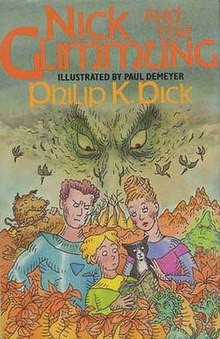
Philip Kindred Dick was an American science fiction writer. He wrote 44 novels and about 121 short stories, most of which appeared in science fiction magazines during his lifetime. His fiction explored varied philosophical and social questions such as the nature of reality, perception, human nature, and identity, and commonly featured characters struggling against elements such as alternate realities, illusory environments, monopolistic corporations, drug abuse, authoritarian governments, and altered states of consciousness.

The Three Stigmata of Palmer Eldritch is a 1965 science fiction novel by American writer Philip K. Dick. It was nominated for the Nebula Award for Best Novel in 1965. Like many of Dick's novels, it utilizes an array of science fiction concepts and explores the ambiguous slippage between reality and unreality. It is one of Dick's first works to explore religious themes.
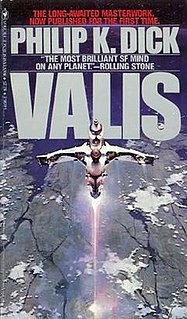
Valis is a 1981 science fiction novel by American writer Philip K. Dick, intended to be the first book of a three-part series. The title is an acronym for Vast Active Living Intelligence System, Dick's gnostic vision of God. Set in California during the 1970s, the book features heavy auto-biographical elements and draws inspiration from Dick's own investigations into his unexplained religious experiences over the previous decade.

Galactic Pot-Healer is a science fiction novel by American writer Philip K. Dick, first published in 1969. The novel deals with a number of philosophical and political issues such as repressive societies, fatalism, and the search for meaning in life.

The Virgin New Adventures are a series of novels from Virgin Publishing based on the British science-fiction television series Doctor Who. They continued the story of the Doctor from the point at which the television programme went into hiatus from television in 1989.

First contact is a common science fiction theme about the first meeting between humans and extraterrestrial life, or of any sentient species' first encounter with another one, given they are from different planets or natural satellites. The theme allows writers to explore such topics such as xenophobia, transcendentalism, and basic linguistics by adapting the anthropological topic of first contact to extraterrestrial cultures.
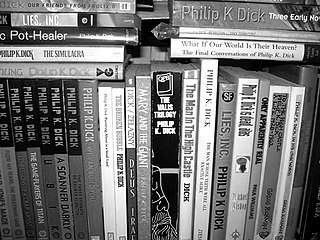
The bibliography of Philip K. Dick includes 44 novels, 121 short stories, and 14 short story collections published by American science fiction author Philip K. Dick during his lifetime.

Vulcan's Hammer is a 1960 science fiction novel by American writer Philip K. Dick. It was released originally as an Ace Double. This has been considered to be the final outing of Dick's 1950s style pulp science fiction writing, before his better-received work such as the Hugo Award-winning Man in the High Castle, published a year later.

Hestia is a 1979 science fiction novel by American writer C. J. Cherryh. It is an early novel in her career, about colonists on an alien world and their interactions with the catlike natives, centering on a young engineer sent to solve the colonists' problems, and his relationship with the young native cat-woman in scanty clothing on the cover.
David F. Bischoff was an American science fiction and television writer.
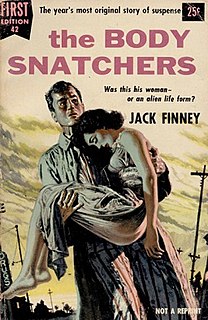
The Body Snatchers is a science fiction novel by American writer Jack Finney, originally serialized in Collier's magazine in November–December 1954 and published in book form the following year.
The planetary systems of stars other than the Sun and the Solar System are a staple element in many works of the science fiction genre.
Illegal Aliens is a science fiction comedy novel written by Nick Pollotta and Phil Foglio.

In Milton Lumky Territory is a realist, non-science fiction novel authored by Philip K. Dick. Originally written in 1958, but rejected by prospective publishers, this book was eventually published posthumously in 1985 by Dragon Press. It was published in two editions. Fifty copies were bound in quarter leather and included a signature from one of the author's canceled checks but were not jacketed. Nine hundred fifty copies were published with a cloth binding and included a dust jacket. It was reprinted in paperback in 2006.

Galactic Odyssey is a science fiction novel by American writer Keith Laumer. It was originally serialized in If magazine from May to July, 1967, under the title Spaceman. Later the same year it was published as a standalone novel titled Galactic Odyssey.

Emily Devenport is an American science fiction writer. She has written seven novels under her name, one novel under the pseudonym Maggy Thomas, and two novels as Lee Hogan.
The Color of Distance is a science fiction novel by American writer Amy Thomson, published in 1995 by Ace Books. It was nominated for a Philip K. Dick Award in the category Best Paperback Original Novel. The sequel is Through Alien Eyes.
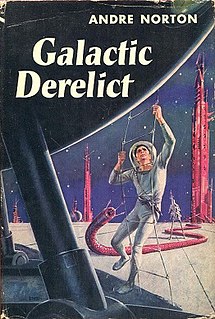
Galactic Derelict is a science fiction novel by American writer Andre Norton, the second in her Time Traders series. It was first published in 1959, and as of 2012, had been reprinted in eight editions. It is part of Norton's Forerunner universe.

Key Out of Time is a science fiction novel by American writer Andre Norton, the fourth in her series The Time Traders. It was first published in 1963, and as of 2012, had been reprinted in 17 editions with cover changes, as well as twice in a combined edition with The Defiant Agents. It is part of Norton's Forerunner universe.

Project Pope is a science fiction novel by the American author Clifford Simak, published in 1981 by Ballantine Books. The novel is about a group of robots and humans living on a planet called the End of Nothing. Their mission is to search the universe and other dimensions to seek out true religion and knowledge. They add the information they gather to their Pope, a robotic supercomputer, in order to make an infallible authority of all knowledge and religion. The novel was nominated for both a Hugo Award for Best Novel and a Locus Award for Best SF novel in 1982.
